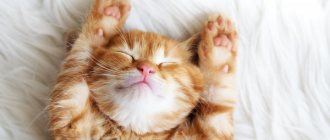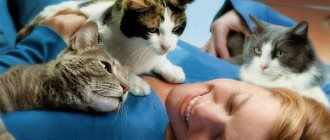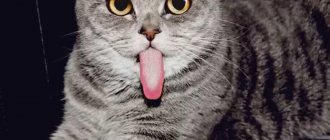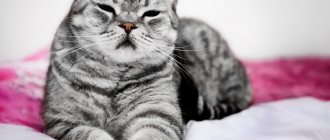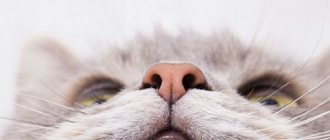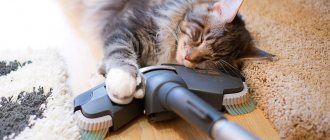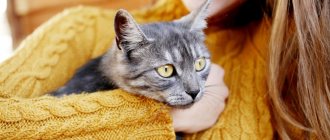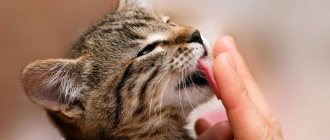The purring of a cat is one of the most pleasant sounds for an animal owner. But the mechanism of origin and its properties still remain a mystery. Even felinologists cannot say exactly when cats learned to purr. It seems that the hoarse vibrating sound relates exclusively to the expression of emotions, but this is not so.
Let's find out what a cat purrs about and how to react to this behavior of a pet.
What is purring and who, besides a cat, makes it?
It is believed that a cat's purring calms both the pet and others. Although objectively this acoustic vibration can also be an alarming signal.
Not only domestic cats purr, but also some inhabitants of the wild world:
- Gorillas, elephants and squirrels can rumble. The desire to express pleasure sometimes appears during food.
- Hyenas, foxes and bears with badgers also periodically grumble and make a sound similar to the purring of a cat.
- A team of predators (from lynx to tiger) is “carried away” by purring singing.
A person hears all this motley “company” only in the zoo from a safe distance, but the sounds of cats at any volume level can be fully enjoyed at home.
If we formulate it without emotional connotation, then purring cats produce a vibrating sound of varying duration in a predominantly low tonal register.
Although there is some gradation in the cat’s vocal roulades, it relates more to the place and circumstances - the cat’s purring changes even depending on the mood of its owner, on whose lap it is located.
This is interesting! Even musicians who can imitate the voice of any animal have not been able to create with their instruments a sound similar to the way cats purr next to a person.
For what reasons does a cat purr?
When answering why cats purr, many owners confidently say that the reason lies in positive emotions. This answer is correct, but incomplete. Sometimes purring is also triggered by negative emotions. You can only understand your pet's desires over time by remembering the difference in volume, duration and frequency of sounds.
Positive emotions
The ability to make a vibrating sound appears in kittens on the 2nd day after birth.
This is necessary to communicate with the mother. The purring of the babies indicates their satiety and good health, and the sounds emanating from the mother cat confirm the safety of her offspring.
In the wild, light vibrations are not detected by other predators, but are clearly perceptible to parents located at a long distance. This helps protect the litter until it becomes independent.
Among the positive emotions that awaken purring are:
- greeting the owner or communicating with other animals;
- going to bed before bed;
- gratitude for the treat or affection received;
- attracting the opposite sex;
- trying to beg for something tasty;
- interest in some object (delicious food) or object (a bird outside the window).
According to one version, cats purr to prevent muscle diseases that threaten them due to too much sleep. Vibrations spreading throughout the body have a positive effect on ligaments, bones and muscles, helping to reduce the load on the musculoskeletal system.
Negative emotions
Purring also occurs when a furry pet is under stress. The vibrations help him stabilize his blood pressure and bring his pulse back to normal.
Sometimes the reason lies in illness. Purring is a physiological pain reliever. It speeds up metabolism and promotes rapid regeneration. Try to observe how a cat purrs after sterilization: the frequency and volume of the sound will differ from usual until the end of rehabilitation.
One of the possible complications of coronavirus infection is feline infectious peritonitis. Its alternative name is “purring disease.” Due to damage to the blood vessels, some of the fluid enters the peritoneum and lungs, causing peritonitis. The bloating that appears is accompanied by a characteristic purring sound.
Also, mustachioed pets purr when their owner strokes them incorrectly or when a more formidable opponent tries to scare them. In the second case, they demonstrate their defenselessness, trying to avoid a possible fight.
Mechanism of purring (vocal cords, diaphragm, vascular theory)
One of the options for the formation of unusual sounds that representatives of the cat family make relates to the work of the respiratory organs, muscles in the larynx and vocal cords.
Studies using an electromyograph (a device for studying bioelectrical muscle potentials) have shown the mechanism of a cat's purring to be the use of vocal folds or laryngeal muscles. By rapidly alternating expansion and contraction of the sound passage, they cause rhythmic continuous vibrations of air in the inhalation-exhalation cycle.
It is in this cycle that the characteristic rumbling of a cat is born. The hypothesis does not illustrate all the features of the occurrence of noise, and therefore remains one of the puzzles in a puzzle that has not yet been solved.
Another failed discovery is the launch of the mechanism through the lungs and diaphragm. Observers came to this conclusion when they compared the cat’s purring and its breathing pattern. But they were never able to explain the entire line of behavior, from managing desire to its implementation.
Blood pressure was also not forgotten. They checked how it circulates through the vessels and even suggested the presence of hemodynamic processes - purring is formed as blood moves through the chest. No irrefutable evidence has been found, but at the level of rumors, this hypothesis is being discussed among cat lovers.
The next point of serious research is the hyoid bones and the degree of their hardening. It was noticed that animals cannot both purr and growl at the same time. Therefore, purring cats were enrolled in one group, and roaring cats in the other.
A characteristic feature of the first (including domestic ones) is a completely ossified ligament of the hyoid bones, while in representatives of the second group this property is partially expressed. The exception is the snow leopard. He can purr, like a cat next to a person, but his hyoid bones are not hard.
The most reliable option explaining purring is neurophysiological. A neural network oscillator was discovered in a cat's brain. This phenomenon is complex and even in humans has not been fully studied. Its job is to cause brain waves, which cause the nervous tissue to generate oscillatory activity. These impulses seem to control the hyoid bones, and they, in turn, cause the vocal cords to vibrate.
This is interesting! Cats purr with both their nose and mouth at the same time. At the same time, the body resonates so much that it is impossible to listen to the work of the heart or lungs.
Where is the cat's urch located?
Rumbling is a low, continuous sound. Take a closer look at what the cat purrs. The process looks as if the purrs are emitting a characteristic belly rumble, but this is not the case. Sound originates in the apparatus between the base of the skull and tongue. Here is a group of thin hyoid bones. Contraction of the muscles of the cat's vocal cords leads to vibrations of the bones. Then the muscles of the larynx are connected, and our ear begins to catch the rumbling.
Citi Kitty cat toilet training system
Price: 720 rub.
1080 rub.
33% discount for you!
Trains in 3 weeks. Fast delivery throughout Russia. And also more than 3,000 other pet products at competitive prices! Take a look!
Urchalnik design
Scientists have spent a lot of effort to find out what a cat purrs with, what the design of the purr is, and where the purr is located. The pattern of the process of rumbling formation is similar to the reproduction of sounds by humans, with some differences. The algorithm for generating sounds in cats consists of the following actions:
- air from the lungs passes through the vocal cords into the larynx;
- vibrations cause resonance in the hyoid bone.
A person uses the tip of his tongue to produce vowels. Cats tense the muscles in their nasal sinuses and mouth. Tone appears in the throat and lips. Then sounds are formed. Cats produce consonants by changing resonance and opening their mouths.
Approximate diagram of a cat
Scheme for reproducing rumbling sounds
Purring is the result of vibrations and vibrations. But not everything is so simple. To the question: where is the cat’s urchin located, scientists have not given a definite answer. Let's consider other options for searching for the place where cats have a purr.
In search of the birthplace of vibrations, a group of scientists determined what makes a cat purr. In their opinion, it is the false cords that vibrate. Others prove that vibrations in the chest and throat are of a nature associated with blood circulation in the vessels. But most are inclined to argue that the purr is a structure made from the hyoid bones.
The question of where a cat’s urinal is located has been of interest for a long time. Rumbling is a property of all cats. Scientists studied how sounds are formed in other members of the family to find out where the cat’s purr is located.
Lions, tigers and leopards, due to the presence of dense cartilage over the hyoid bones, do not purr like their smaller counterparts. Cartilage prevents bones from vibrating, but strengthens the vocal apparatus. That's why lions and tigers make loud noises, like growls, and do this while exhaling.
Lynxes, cats, ocelots and other small-sized representatives of the family can purr during inhalation and exhalation. This discovery helped to figure out which organ the cat purrs.
The main reasons for a cat's purring
The most common causes of cat purring are:
Little kittens purr literally from the moment they are born. Sometimes this skill comes to them later, and some do not master the “vocal” art until the end of their days. But the presence or absence of this quality depends on the breed and other individual reasons.
The loudest "purrs"
The former, current and unofficial Guinness World Record holders for the loudest purr all live in Britain.
The volume of sounds made by domestic cats averages 25 decibels. But in 2011, a cat named Smokey was included in the Guinness Book of Records for the loudest purr. The volume of the sounds it made was 67.68 decibels.
The new record holder is a cat named Merlin. He is 13 years old and also lives in Britain. The cat's owner, Tracy, independently measured the volume of her pet's purring and received a result of 98 to 100 decibels. The first official measurements did not give a positive result - the volume did not exceed the existing record. However, the owner resorted to a trick: she gave her beloved cat a delicious fish, and he, as a sign of gratitude and pleasure, broke Smokey’s record.
The unofficial record holder, a cat named Bluey, also lives in Britain. It produces sounds equal to 93 decibels. However, the owners of the “purr” never submitted an official application to the Guinness Book of Records.
These are the unusual and amazing cats that exist in the world. They amaze us with their ability to purr loudly, and the owners command respect and surprise us with their endurance - after all, not everyone can tolerate a cat that “purrs like a tractor” next to them.
Why do cats purr next to a person (when you pet them, they crush them with their claws and lie on their owners)
The gift of healing ailments belongs to the most mysterious section of the cat encyclopedia. The point, apparently, is in the frequency of sounds made and not only in them.
Most likely, cats purr and lie on their owners, thanks to the natural instinct to settle in the warmest place. Inflamed areas of the body have an increased temperature, so the pet chooses them instinctively.
Even traditional stomping (with or without claws) can be considered a massage, but scientists attribute this ability to a genetic memory of preparing a den for sleep.
Cat-human interaction
The way a cat purrs depends on the person. A purring pet can trample its paws on its owner, lie down on top or next to it. All these actions have their explanation.
Showing affection
If you stroke your mustachioed pet, he will soon begin to purr. This means that he enjoys touch and communication with a person. When stroking against the grain or by a stranger, you can see the opposite effect. The animal will be angry or frightened and will hasten to leave with a threatening hiss.
Foot trampling
The most popular interpretation of trampling is the “milk step”. Kittens make similar movements on their mother's chest, stimulating the faster production of milk. Fingering with paws is also associated with:
- showing gratitude and demonstrating trust in a person;
- unrealized sexual instinct in castrated animals;
- treating the owner or relieving one’s own stress;
- preparing a comfortable place to sleep.
If your pet releases its claws when trampling, do not scold it. He does not control this action, so pet him and place a thick blanket or pillow under his paws.
Lying on or next to a person
Lying nearby is the highest form of trust and love. The animal feels safe with its two-legged owner. If a person is unwell, a furry pet can lie on top, sending its healing vibrations to the sore spot.
How to determine by purring what a cat wants
The meaning of a cat's purring depends on the animal's mood and health.
- He rubs against his legs, purrs and arches his back - he greets and attracts attention.
- It rumbles as soon as the owner is in the kitchen, next to food - he wants to eat.
- She settled down next to the owner somewhere on the sofa, purred, demanding affection.
- It bends over, stomps in one place and purrs endlessly - probably the animal is in pain.
- The unreasonable purring of a cat that is resting means that it has found a comfortable place for itself.
The main causes of cat purring
Cats may purr for many reasons:
- They purr to show pleasure. Cats often purr when people pet them.
- Cats may purr in anticipation of something pleasant - tasty food or entertainment.
- Purring can be a sign of relaxation and often accompanies dozing and the beginning of bedtime - this makes it easier for animals to fall asleep. During deep sleep, cats cannot purr.
- Purring may be a way of communicating with others. For example, if one cat purrs in front of another, he is showing that he is friendly and has no plans to attack or otherwise express aggression.
- This sound is used by cats to communicate with kittens to calm them down. When kittens hear their mother purring, they feel safe.
- Animals may purr when they are trying to make a person feel better. It is believed that the sound vibrations that cats emit when purring have a beneficial effect on human health and help with cardiovascular diseases, gastrointestinal disorders and stress disorders. When cats feel that their owner is feeling unwell, they lie down on the person’s lap or chest and move their front paws, accompanying these movements with purring.
- Animals can purr in an attempt to help not only their owners, but also themselves. Sometimes the reason why cats purr like a tractor is because they are stressed or sick. It has been scientifically proven that the vibrations generated when creating a purring sound improve the animal's blood circulation and metabolism. Cats can also use purring to try to calm themselves down when they are scared. Animals have been observed to purr before their own death.
One of the scientists' explanations for why cats purr is that creating sound helps animals keep their muscles toned.
Most of their lives, cats are inactive - they prefer to lie down or sleep. When they make a characteristic purring sound, they prevent atrophy of muscles and ligaments.
Purring is also beneficial for animals, because the frequency of vibrations that occur when creating sound has a beneficial effect on the muscular and skeletal systems of cats.
What to do if your cat doesn't purr
Arbitrary options for the appearance or absence of “musical” abilities in cats are possible:
Vibration and sound, typically signifying the purring of a cat, is an optional sign of mood, breed or attitude towards a person.
Why do cats have a problem?
Flatulence
Most often, a kitten's tummy is seething precisely due to bloating and increased gas formation in the intestines. This problem is common not only to people, but also to pets. In addition to the unpleasant aroma that comes from the animal, the owner may notice the cat's anxiety. If you touch her belly, she may begin to react inappropriately. This behavior is caused by pain.
In addition, sometimes gas formation is so severe that the pet has difficulty breathing, drooling, and other symptoms appear that indicate insufficient blood supply to the lungs. Flatulence in a kitten is often caused by gluttony. If a cat eats too much food, it simply does not have time to be digested. As a result, putrefactive processes are observed, which become the cause of rumbling, release of gases and toxins. If timely assistance is not provided, the cat may experience severe intoxication of the body, which can even lead to death.
The following factors can provoke flatulence in pets:
If a cat eats fermented milk products excessively, they can provoke such a symptom.
- eating stale food;
- allergic reactions to products;
- balls of hair in the intestines;
- helminthic infestation;
- abuse of fermented milk products.
Aerophagia
Gluttony also causes this phenomenon, which is an increased swallowing of air during food consumption. When a pet eats food too greedily, at the same time it swallows air. A small amount of it comes out during belching, while the rest penetrates the intestines, causing the kitten’s tummy to rumble. Then the air comes out naturally, which is why aerophagia is often confused with flatulence. However, unlike it, swallowing air does not pose a danger to the health and life of the cat. To cope with the problem, the first thing the owner needs to do is start feeding the cat more often, making the portions smaller.
Worm infestation
If your cat is vomiting and has a rumbling stomach, worms are often the cause. In addition to these symptoms, you can notice a serious increase in the size of the abdomen against the background of general thinness and exhaustion of the pet. Pets experience constant diarrhea, the feces take on a green tint and smell unpleasant. The body can contain hundreds of parasites that produce toxins during their life. If antihelminthic therapy is not carried out, the cat may die due to serious poisoning.
Purulent discharge from the nose and eyes of an animal is one sign of a parasitic infestation.
Intestinal helminthic infestation provokes the development of the following symptoms:
- yellowing of mucous membranes;
- increase in liver size;
- itching of the perianal area;
- hair loss;
- discharge of pus from the nose and eyes;
- blood impurities in stool.
Diseases
If a cat's stomach growls loudly, inflammatory processes in the pancreas may be to blame. As they progress, the owner may notice the cat vomiting, constant diarrhea, and loss of appetite. Often the cause of the problem is an ulcer of the stomach and duodenum. Rumbling is also characteristic of colitis, enteritis and gastritis. The characteristic sounds in the abdomen that develop against the background of these diseases arise due to disruption of the digestion of food and the movement of feces.
When the problem is due to nutrition
Indigestibility of milk can cause discomfort in the animal's abdominal area.
Rumbling in a cat's stomach can be caused not only by eating poor quality food, but also by intolerance to certain foods. For example, most pet owners are convinced that milk is an ideal treat for cats. However, this opinion is not true, since the body of almost all adult cats does not produce enzymes that allow them to digest fermented milk products. Drinking milk causes increased gas production and grumbling.
In addition, some cat owners do not hesitate to give them waste from their table. Veterinarians from the Zoovet clinic categorically do not recommend doing this. A pet's diet should include exclusively healthy food that contains sufficient amounts of vitamins and microelements. The cat menu includes lean types of meat. It is recommended to pay attention to turkey, chicken, rabbit and veal. Buckwheat and rice porridge, eggs and vegetables will help improve the digestive process.
It is permissible to give boiled sea fish no more than once a week.
Other factors
Similar sounds can be heard when a hungry pet drinks water.
A cat’s stomach can growl not only from gluttony, but also from starvation. In addition, often the problem lies in the water, which, when it ends up in an empty intestine, makes characteristic sounds. They are most noticeable when the pet drinks cold liquid. It has an irritating effect on the mucous membranes of the intestines, as a result of which it begins to contract. The air moves actively and provokes a rumbling tummy.
The most purring breeds
Until now, no pattern has been identified that explains the desire of cats to purr. Owners are inclined to the theory of sociability - the more sociable the animal, the more talkative it is. This means that the cat that purrs is one that wants to spend time with its owner. Pedigree and street cats have equal chances here.
As for the volume level, its maximum is 20 decibels, which is quite comfortable for human hearing. For comparison, street noise is 2.5 times louder.
This is interesting! The mongrel cat Smokey from England became famous for her outstanding purring - she purred 68 dB, was included in the Guinness Directory, and at the same time forced her owner to move away from her neighbors.
The benefits of cats purring for humans
Many believe that hugging a purring cat has a positive effect on human health.
Bone Health
Broken bones won't magically mend when a cat purrs nearby, but a low noise of 25 to 50 Hz will promote their healing. These vibrations will strengthen bone tissue and help fractures heal faster. The second best frequency for this type of healing power is between 100 and 200 Hz.
Less stress
The best thing to do after a busy day at work is to sit on the sofa and let your cat crawl into your lap.
Stroking a purring cat has an automatic sedative and sedative effect that lowers your heart rate and helps relieve stress.
Easy breath
This of course doesn't work if the person is allergic to cats, but purring is known to help relieve symptoms of shortness of breath. Purring encourages us to imitate a cat's inhalation and exhalation, and the sensation of vibration helps the lungs work rhythmically.
Wound care
A kitten's claws may sometimes catch on the skin, leaving scratches, but he will make up for this later during cuddles. Vibrations from purring stimulate wound healing. In addition, a cat's purring helps our body fight infection and reduce swelling.
Healing soft tissue
If the injury is deeper than the skin, a cat can still help. Torn muscles and tendons and other types of ligament injuries will heal faster if there is a cat in the house. Placing a purring cat directly over a sore spot won't produce immediate results, but many say the vibrations can help the sufferer get back on their feet faster.
Heart Health
In 2009, more than 4,000 participants, including cat owners and people without pets, were surveyed to determine whether being around a cat actually reduced the risk of heart disease.
Their results are proof that adopting a feline friend can save lives. Purring reduces stress, lowers blood pressure and ultimately helps prevent heart attacks.
The general consensus in the scientific and medical world is that owning a cat will help you live a longer, healthier, and happier life. If you needed one reason to stay home and cuddle your cat, this is it. This is also a great excuse to add a few more furry friends to your family.
